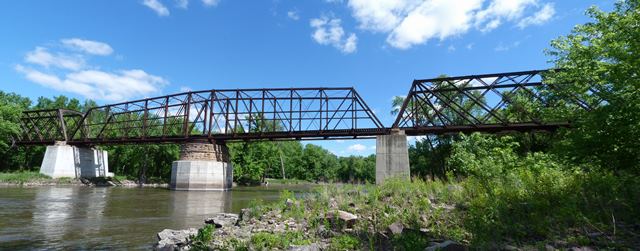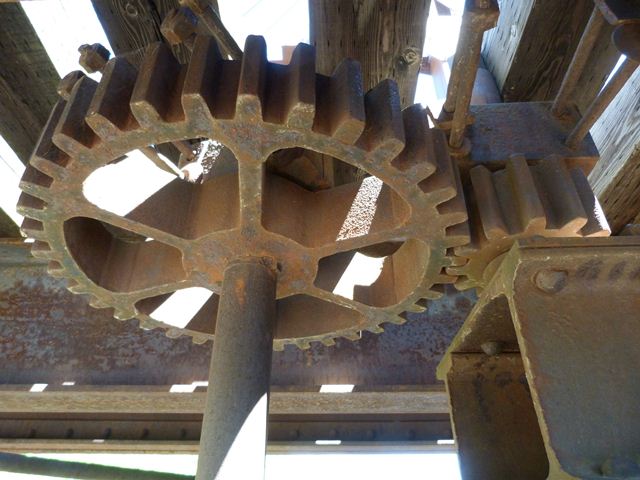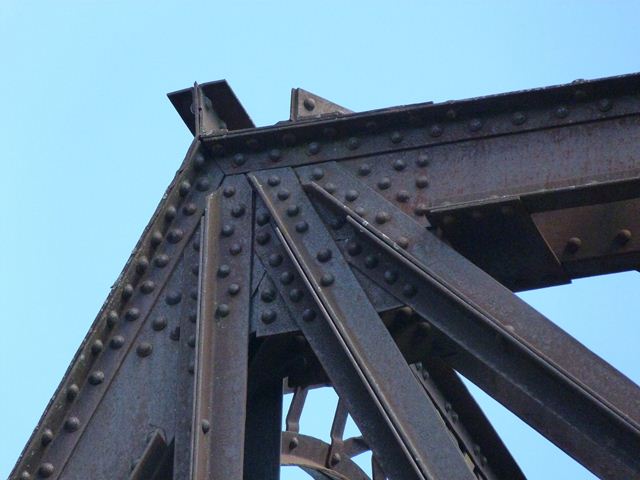We Recommend:
Bach Steel - Experts at historic truss bridge restoration.
BridgeHunter.com Phase 1 is released to the public! - Visit Now
Redstone Bridge
Chicago and NorthWestern Bridge 432

Primary Photographer(s): Nathan Holth
Bridge Documented: June 2, 2013
Railroad (Dakota, Minnesota, and Eastern Railroad) Over Minnesota River
Rural: Brown County, Minnesota and Nicollet County, Minnesota: United States
Metal 13 Panel Pin-Connected Camelback Through Truss, Movable: Swing (Center Pier) and Approach Spans: Metal 11 Panel Rivet-Connected Lattice (Quadruple Warren) Through Truss, Fixed
1880 By Builder/Contractor: Rust and Coolidge of Chicago, Illinois and Leighton Bridge and Iron Works of Rochester, New York
Not Available or Not Applicable
206.0 Feet (62.8 Meters)
880.0 Feet (268.2 Meters)
Not Available
1 Main Span(s)
Not Applicable

View Information About HSR Ratings
Bridge Documentation
Additional Information: Rust and Coolidge of Chicago, Illinois built the swing span, while Leighton Bridge and Iron Works of Rochester, New York built the fixed approach spans.
This bridge is one of the oldest known truss bridges in Minnesota with an 1880 construction date. More importantly, this bridge should be considered nationally significant as one of the oldest known railroad swing bridges in the entire country. Even when included among highway bridges, it is among the oldest known swing bridges. This main swing span is pin connected and the truss is shaped as a single span through truss over the swing pier, as opposed to some swing bridges where they are configured like a two span truss bridge with a tower connecting the two spans over the swing pier. On either side of its main swing span is a single fixed quadruple Warren through truss span, which is a type of lattice truss. These spans are among the oldest known examples nationwide of lattice metal truss bridges. Moreover, as rivet-connected truss spans, they are also among the oldest known rivet-connected truss bridges in the country. Finally, it should be noted that the bridge has simple wooden "trestle" style approach at the far western end. In summary, because of its truss spans, this bridge has multiple layers of historic significance at the national level.

This bridge has not operated for boats for a very long time. It is a hand-turned swing bridge and appears to have always been a hand-turned swing bridge. As a hand-turned swing bridge, the design is very simple (compared to most movable bridges) and all the mechanics that are needed to make the bridge swing appear to remain in place and have not been removed. This is important from a historical significance standpoint since it means that this ancient surviving swing bridge actually survives today as a functional swing bridge, even if the bridge may have been mechanically locked in place. In theory, if the deck and any mechanical items added to keep the bridge fixed in place were removed and/or reconfigured, this bridge could be made to operate again with perhaps as little as some grease.
At a casual glance, this bridge's trusses appear to be unaltered because everything appears to be riveted and there are no major signs of welds, bolts, or other "modern" alterations to the truss. However, for a bridge of this age, it would be unusual for there to be no alterations, especially since railroad loads tended to increase in the 20th Century and many bridges from the era of this bridge were replaced. It makes sense that this bridge might have been strengthened, perhaps so long ago that traditional historical construction methods (like riveting) were used, so that alterations blend in with the original construction far better than modern repair and alteration methods do. However, to complicate matters, a bridge built in 1880 would have lacked standardization seen in later truss bridges. Therefore, some details on this bridge that look odd and might lead one to believe they are alterations might in fact be a non-standard but nevertheless original detail on the bridge. Without a detailed plan set, it is not possible to know 100% what is original and what is added.
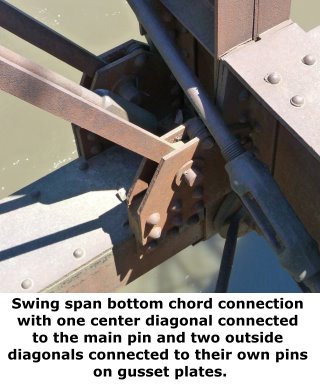
This bridge's swing span has some unusual details at the connections. See the photo above, which is an example of how some of the diagonal members are composed of three diagonal bars, where one center diagonal is an eyebar attached to the main pin in a traditional fashion. The additional two diagonals are also eyebars, but they each attach to their own unusual pairs of gusset plates which itself has a pin to which the diagonal members are attached. Rivets hold the two pairs of gusset plates together, but because the pairs of gusset places are spaced slightly apart from each other (to make room for the eyebar head) they put a pile of washers in between the gusset plates to give the rivets something to grip in between the gusset plates. Although it is possible they are original, it is quite conceivable that these unusual gusset plate/pin connections are alterations. The way they are mounted to the outside of the bottom chord would have made them easy to add to the bridge, and the somewhat unusual method of simply piling washers in between the gusset plates so the rivets would work does not seem like a typical procedure for new bridge construction at the time.
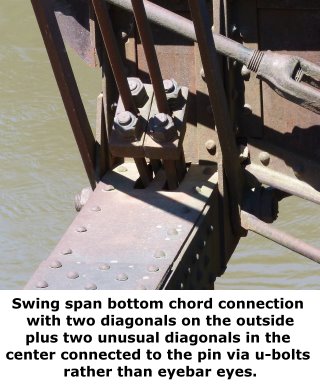
Some other swing span diagonal members are configured in yet another way, where four diagonal bars can be seen. See the photo above Looking at the bottom chord connections on these panels, it can be seen that there are two diagonals connected to the main pin on the outside of the bottom chord. In the center, two more diagonal members connect to the main pin. However, instead of connecting to the main pin by way of an eyebar head, these two center diagonal bars are connected to the main pin by way of u-bolts. While it is possible that these are original details, it is again quite conceivable that these u-bolt connected diagonals are not original and are additions to the bridge, especially if you think of the advantage a u-bolt would offer as a method of adding a diagonal bar to an existing pin-connected truss bridge. Think about a traditional eyebar and pin connection. To get two additional diagonal bars attached to the main pin in between two original diagonal members you would have to dismantle half or more of the connection... since in order to slide an eyebar eye onto the pin you would have to move things like the outside diagonals, pin plates, possibly even the bottom chord, to be able to slide the additional eyebar onto the pin. However, with a u-bolt, the u-bolt can be simply slipped over the pin and the diagonal bar bolted into place afterward.
Finally, an unusual detail seen on all truss spans is that post-tension rods are present on all floor beams. These rods are wrapped around the ends of the floor beams on a cast iron saddle and they then move under the floorbeam where they are bolted and riveted. Turnbuckles are present on these rods for adjustment of tension. It is not known if these post-tension rods are an original detail or an alteration. Some bridges from ca. 1880 were built with post-tensioning as part of the original design. This was likely done because it was seen as a material savings over using simply larger floor beams to achieve the needed load capacity. However, post-tensioning can also be a way to strengthen existing floor beams.

This bridge does carry trains, but a very small number. Once a through route for Chicago and NorthWestern, this railroad now just serves a nearby gravel pit and is owned by the Dakota, Minnesota, and Eastern Railroad.
The bridge's original stone substructures including piers and abutments have been altered in recent years by the addition of concrete. However, this bridge is not significant because of its substructure, it is the truss superstructure that gives this bridge its significance, so these major substructure alterations do not diminish the national significance of this bridge.

The light use of this bridge by trains, plus the recent substructure repairs suggest this bridge is not at risk for demolition. This bridge is so rare and significant that it should be preserved indefinitely at any cost. The good news is that with the substructure repairs, the bridge sits on sturdy foundations, and the trusses themselves, although not painted, have hardly any deterioration of any kind. This is likely due to the corrosion-resistant properties of the wrought iron that this bridge is almost certainly constructed of.
Despite the fact that HistoricBridges.org has observed this bridge to be a nationally significant historic bridge, it has not received much attention from official governmental or organizational sources. However, the bridge has caught the attention of historic bridge enthusiasts, including webpages maintained by John Weeks and John Marvig.

![]()
Photo Galleries and Videos: Redstone Bridge
Structure Overview
Original / Full Size PhotosA collection of overview photos that show the bridge as a whole and general areas of the bridge. This gallery offers photos in the highest available resolution and file size in a touch-friendly popup viewer.
Alternatively, Browse Without Using Viewer
![]()
Swing Span, Structure Details
Original / Full Size PhotosA collection of detail photos that document the parts, construction, and condition of the bridge. This gallery offers photos in the highest available resolution and file size in a touch-friendly popup viewer.
Alternatively, Browse Without Using Viewer
![]()
Fixed Truss Spans, Structure Details
Original / Full Size PhotosA collection of detail photos that document the parts, construction, and condition of the bridge. This gallery offers photos in the highest available resolution and file size in a touch-friendly popup viewer.
Alternatively, Browse Without Using Viewer
![]()
Structure Overview
Mobile Optimized PhotosA collection of overview photos that show the bridge as a whole and general areas of the bridge. This gallery features data-friendly, fast-loading photos in a touch-friendly popup viewer.
Alternatively, Browse Without Using Viewer
![]()
Swing Span, Structure Details
Mobile Optimized PhotosA collection of detail photos that document the parts, construction, and condition of the bridge. This gallery features data-friendly, fast-loading photos in a touch-friendly popup viewer.
Alternatively, Browse Without Using Viewer
![]()
Fixed Truss Spans, Structure Details
Mobile Optimized PhotosA collection of detail photos that document the parts, construction, and condition of the bridge. This gallery features data-friendly, fast-loading photos in a touch-friendly popup viewer.
Alternatively, Browse Without Using Viewer
![]()
Maps and Links: Redstone Bridge
Approach the bridge from 571st Lane from the north, off US-14.
Coordinates (Latitude, Longitude):
Search For Additional Bridge Listings:
Bridgehunter.com: View listed bridges within 0.5 miles (0.8 kilometers) of this bridge.
Bridgehunter.com: View listed bridges within 10 miles (16 kilometers) of this bridge.
Additional Maps:
Google Streetview (If Available)
GeoHack (Additional Links and Coordinates)
Apple Maps (Via DuckDuckGo Search)
Apple Maps (Apple devices only)
Android: Open Location In Your Map or GPS App
Flickr Gallery (Find Nearby Photos)
Wikimedia Commons (Find Nearby Photos)
Directions Via Sygic For Android
Directions Via Sygic For iOS and Android Dolphin Browser
USGS National Map (United States Only)
Historical USGS Topo Maps (United States Only)
Historic Aerials (United States Only)
CalTopo Maps (United States Only)




